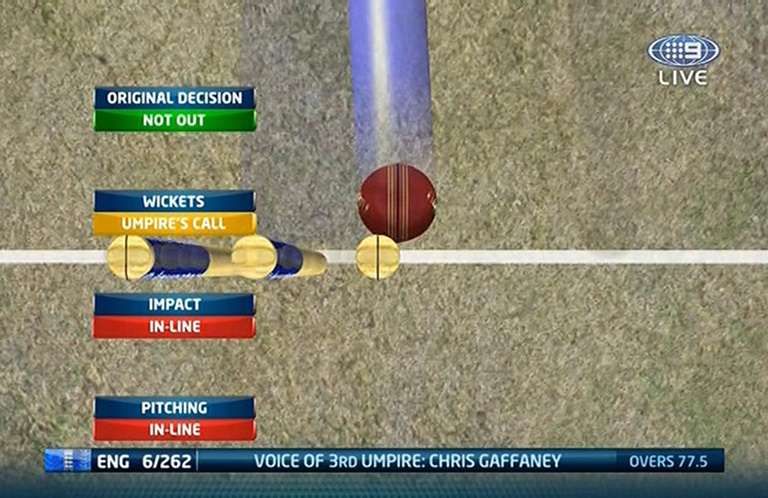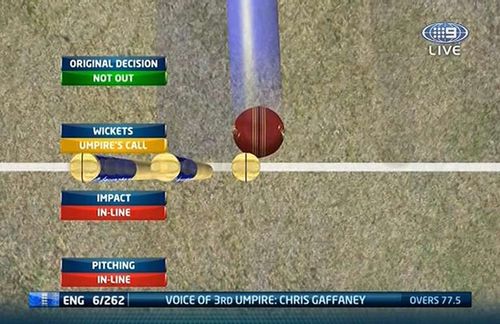
The nuances of 'Umpire's Call' - How it shapes up to an unfair DRS decision

Decision Review System (DRS) has inspired controversy right from the time it was introduced in the game of cricket. Several shortcomings of DRS have been addressed from time to time, but there are some which still spark debates. The ‘umpire’s call’ is one of them.
A couple of decisions which went against Pakistan during the first Test against England inspired debate among the Sky Sports commentary team. Stuart Broad was given not out on the field during England’s first innings. On review, the ball was shown to be trimming the bails.
A similar incident happened in Pakistani pacer Mohammad Rizwan's case, but this time the on-field umpire had given out. On both occasions, the on-field umpire’s decision was upheld owing to the 'umpire’s call'.
Michael Holding, who has been critical of this aspect of DRS for long, once again raised the issue in the commentary box. The former West Indies fast bowler opined that when the ball is shown to be clipping the bails, it has to be either out for all, or not out.
“You know I’ve been talking about how it’s so important that the first decision on the field is correct. That’s so that whenever you have a referral it’s all about umpire’s call. The benefit of the doubt should go to the batsman. Umpire’s call, there has to be some doubt where the umpire is confirmed, so say not out and then let the technology prove you wrong. There has to be doubt if the ball is clipping the bails,” said Michael Holding during the previous Test between England and the West Indies
What do the statistics show?
The ‘umpire’s call’ has been a vital feature of DRS, especially in case of reviews related to LBW. During Test matches played in 2019, 62 reviews (17%) out of a total of 364 were struck down based on the umpire’s call. The number stands at 26 reviews (19%) in the Test matches played so far in 2020.
It becomes even more significant when the review under DRS is for an LBW. When we look at the numbers since 2012, LBWs are the basis of 3/4th of all reviews. And almost 1/3rd of these are adjudicated based on ‘umpire’s call’.
When we look at the performance of the umpires since September 2017, England’s Micheal Gough leads the way. 95% of the reviews against his decisions have been turned down by the TV umpire. Of this, only 12% was based on ‘umpire’s call’. Kumar Dharmasena is second on the list at 78.7% of decisions endorsed. But this falls drastically after considering the 'umpire’s call’. He is not even in the top 3 after the adjustment.
Nigel Llong has the worst record in this period, getting 63.8% of his reviewed decisions overturned. But he fares much better with the 'umpire's call' aspect. Chris Gaffaney’s record falls to a paltry 42.4% accurate decisions if you include the ‘umpire’s call’ decision which is the worst for any international umpire.
The real problem with DRS - ball-tracking
People often ask why DRS is so debatable when technology is used successfully in other sports like tennis and football. In both these sports, the major decision is based on a line, and what side of it the ball has fallen on. In the case of DRS, the complexity arises majorly since it requires the probable path of the ball to be plotted.
As per Hawk-Eye, the company which makes the ball-tracking technology, if more than 50% of the ball is shown to be hitting the stump, then it is 100% certain that the ball will hit the stumps. But if less than 50% of the ball is shown to be hitting the stumps, then there is no certainty.
The debate arises only in the case of the latter when there is an ambiguity related to the accuracy of ball-tracking.
Different Takes on the Matter of ''Umpire's Call' in DRS
There have been different opinions regarding how to treat the cases when less than 50% of the ball is estimated to be hitting the stumps.
Indian player-turned-commentator Aakash Chopra believes that if less than 50% of the ball hits the stumps, the decision should be not-out, irrespective of the on-field decision. He argues that the decision should go in favour of the batsman when there is a reasonable element of doubt.
“If more than 50% of the ball strikes the stumps, it should be given out. If less than than 50% of the ball strikes the stumps, then whatever be the umpire’s decision, it should be given not out.”
Much like what Michael Holding expressed, Aakash Chopra too doesn’t seem to be in support of the ‘umpire’s call’ aspect of DRS, where the adjudication is based on the on-field decision when less than 50% of the ball hits the stumps.
On the contrary, one of the greats of the game Sachin Tendulkar has opined that if the ball-tracking shows that the ball is hitting the stumps, it should be given out irrespective of what % of the ball is shown as hitting. Current and former cricketers including Harbhajan Singh, Irfan Pathan and Tom Moody came out in support of Tendulkar's theory.
“What % of the ball hits the stumps doesn’t matter, if DRS shows us that the ball is hitting the stumps, it should be given out, regardless of the on-field call. That's the motive of using technology in Cricket. As we know technology isn’t 100% right but neither are humans," said Sachin Tendular
We are not entirely sure what changes, if any at all, will be brought about to make DRS more effective. Both these schools of thought are certainly gaining ground.
The ‘umpire’s call’ in DRS may well have to be reconsidered under the circumstances. DRS was introduced to make the best use of technology, and when technology is being used, there is no harm in relying on it completely. Until the shortcoming is addressed, it would be justified to bring in more objectivity in the decisions.